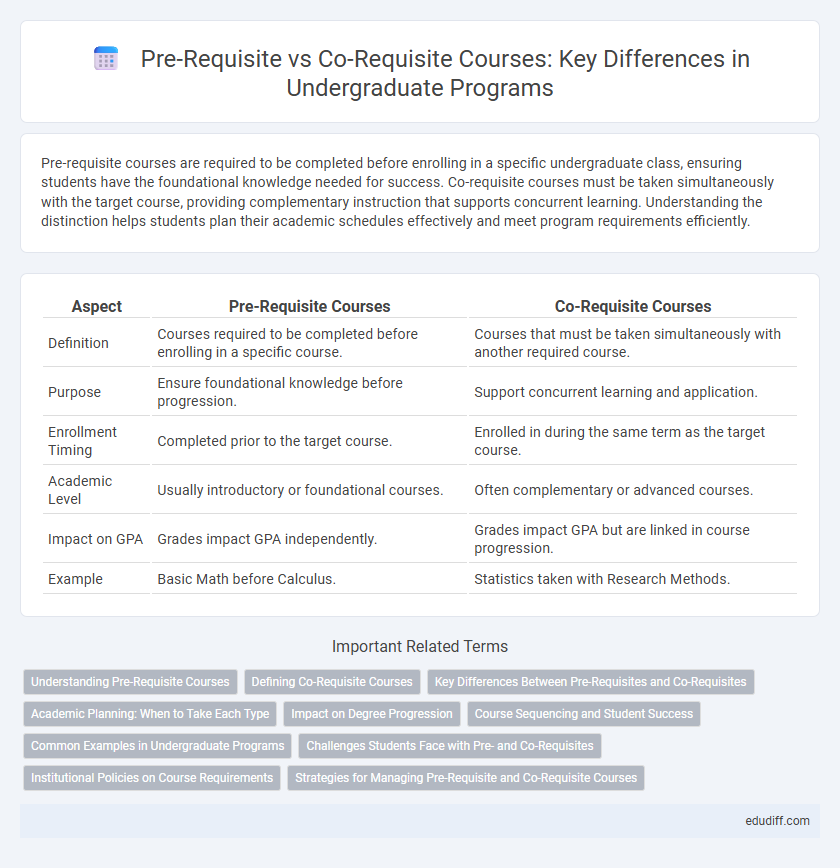Pre-requisite courses are required to be completed before enrolling in a specific undergraduate class, ensuring students have the foundational knowledge needed for success. Co-requisite courses must be taken simultaneously with the target course, providing complementary instruction that supports concurrent learning. Understanding the distinction helps students plan their academic schedules effectively and meet program requirements efficiently.
Table of Comparison
| Aspect | Pre-Requisite Courses | Co-Requisite Courses |
|---|---|---|
| Definition | Courses required to be completed before enrolling in a specific course. | Courses that must be taken simultaneously with another required course. |
| Purpose | Ensure foundational knowledge before progression. | Support concurrent learning and application. |
| Enrollment Timing | Completed prior to the target course. | Enrolled in during the same term as the target course. |
| Academic Level | Usually introductory or foundational courses. | Often complementary or advanced courses. |
| Impact on GPA | Grades impact GPA independently. | Grades impact GPA but are linked in course progression. |
| Example | Basic Math before Calculus. | Statistics taken with Research Methods. |
Understanding Pre-Requisite Courses
Pre-requisite courses are foundational classes that students must complete before enrolling in more advanced courses, ensuring they possess the necessary knowledge and skills for success. These courses establish essential concepts and competencies that support comprehension of higher-level subjects in the undergraduate curriculum. Mastery of pre-requisite courses reduces academic difficulties and enhances overall learning outcomes.
Defining Co-Requisite Courses
Co-requisite courses are classes that students must enroll in simultaneously with a related course to ensure they acquire essential complementary knowledge and skills concurrently. These courses support real-time application and integration of concepts, enhancing the learning process and improving academic success in complex subject areas. Universities implement co-requisite courses to bridge gaps in foundational understanding without delaying progression through the degree program.
Key Differences Between Pre-Requisites and Co-Requisites
Pre-requisite courses are foundational classes that students must complete before enrolling in more advanced courses, ensuring they possess the necessary background knowledge. Co-requisite courses, on the other hand, are classes taken simultaneously to complement each other, often combining theoretical and practical components. The key differences lie in timing and purpose: pre-requisites establish prior knowledge while co-requisites provide concurrent support for comprehensive understanding.
Academic Planning: When to Take Each Type
Pre-requisite courses establish foundational knowledge required before enrolling in advanced subjects, ensuring students develop essential skills early in their academic journey. Co-requisite courses are designed to be taken simultaneously, allowing students to integrate complementary concepts across related disciplines for a cohesive learning experience. Effective academic planning involves strategically scheduling pre-requisites in initial semesters and aligning co-requisites within the same term to optimize progression and graduation timelines.
Impact on Degree Progression
Pre-requisite courses establish foundational knowledge necessary for advanced subjects, ensuring students are adequately prepared before progressing, which helps maintain academic standards and prevents delays in degree completion. Co-requisite courses allow simultaneous enrollment in related classes, facilitating immediate application of concepts and may accelerate degree progression by reducing wait times between course sequences. Effective management of both pre-requisite and co-requisite requirements is critical for optimizing students' academic pathways and timely graduation.
Course Sequencing and Student Success
Proper course sequencing plays a crucial role in student success by ensuring pre-requisite courses are completed before advancing, which builds foundational knowledge necessary for tackling more complex topics. Co-requisite courses, taken simultaneously, provide immediate academic support and reinforce learning through integrated instruction, enhancing comprehension and retention. Balancing pre-requisite and co-requisite courses optimizes curriculum flow, reduces course repetition, and improves timely degree completion rates for undergraduate students.
Common Examples in Undergraduate Programs
Pre-requisite courses such as Calculus I before Calculus II or Introduction to Biology before Genetics establish foundational knowledge critical for understanding advanced topics in undergraduate programs. Co-requisite courses like Physics I and Physics I Lab, or Anatomy with Physiology, are designed to be taken simultaneously to reinforce theoretical concepts through practical application. Understanding these requirements ensures proper course sequencing and academic success in disciplines like engineering, nursing, and natural sciences.
Challenges Students Face with Pre- and Co-Requisites
Students often struggle with pre-requisite courses due to limited foundational knowledge, which delays their progression in major-specific classes. Co-requisite courses require simultaneous mastery of complementary subjects, increasing cognitive load and time management challenges. These challenges can lead to decreased academic performance and extended time to degree completion for undergraduate students.
Institutional Policies on Course Requirements
Institutional policies on course requirements clearly differentiate between pre-requisite and co-requisite courses to ensure proper academic progression. Pre-requisite courses must be completed before enrolling in advanced classes, establishing foundational knowledge essential for success. Co-requisite courses are required to be taken simultaneously, providing complementary skills and content that enhance understanding during the same term.
Strategies for Managing Pre-Requisite and Co-Requisite Courses
Effective strategies for managing pre-requisite and co-requisite courses include careful academic planning and time management to balance course loads and meet sequential requirements. Utilizing academic advising resources ensures students understand course prerequisites and integrate co-requisite classes seamlessly into their schedules. Prioritizing early registration and leveraging tutoring or study groups can enhance comprehension and success in both pre-requisite and co-requisite courses.
Pre-Requisite Courses vs Co-Requisite Courses Infographic

 edudiff.com
edudiff.com